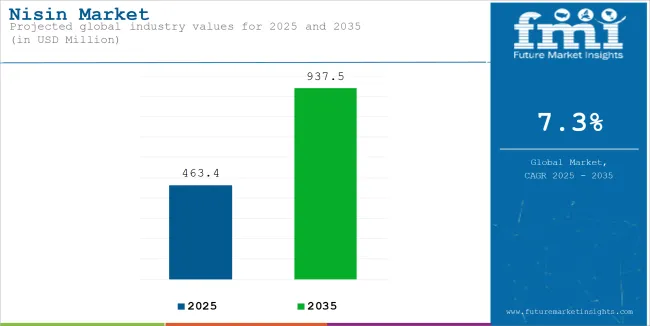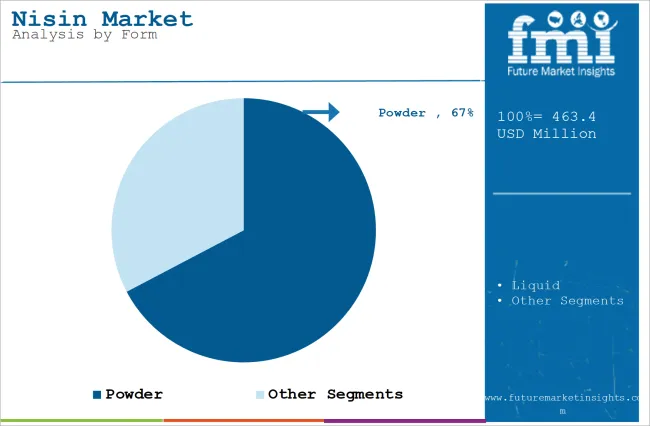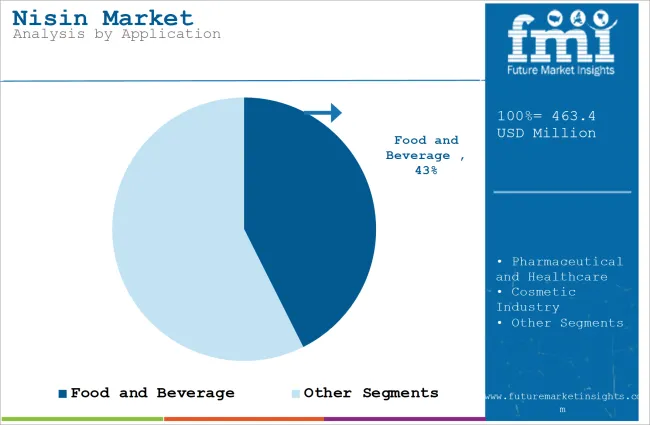The global nisin market is estimated to be worth USD 463.4 million in 2025. It is expected to reach USD 937.5 million by 2035, reflecting a CAGR of 7.3% over the forecast period of 2025 to 2035.
The beverage industry has witnessed a significant rise in the adoption of Nisin as a preservative, driven by its effective antimicrobial properties and ability to enhance food safety and quality. Beverages, particularly those with high moisture content, are prone to microbial contamination, which can lead to spoilage, off-flavors, and safety concerns.
Nisin, with its ability to inhibit the growth of a wide range of harmful microorganisms, including bacteria, molds, and yeasts, has become an essential tool for beverage manufacturers looking to extend product shelf life and ensure safety. Its application in beverages such as juices, dairy drinks, soft drinks, and energy drinks is growing due to its efficacy in preventing spoilage and enhancing the overall quality of the product.
One of the key advantages of Nisin is that it is a natural preservative, which aligns with the increasing consumer demand for clean-label products and a preference for minimal use of artificial additives. This shift toward natural ingredients has encouraged many beverage producers to seek out alternatives to synthetic preservatives, making Nisin a favored choice.
Additionally, Nisin’s ability to work effectively in a wide pH range, from acidic fruit juices to neutral beverages, further boosts its versatility and applicability across different product categories. As consumers continue to prioritize health and safety, the demand for beverages with longer shelf life and fewer preservatives is growing, and Nisin fits perfectly within these trends.

| Attributes | Description |
|---|---|
| Estimated Global Nisin Industry Size (2025E) | USD 463.4 million |
| Projected Global Nisin Industry Value (2035F) | USD 937.5 Million |
| Value-based CAGR (2025 to 2035) | 7.3% |
Antimicrobial Properties of Nisin Drive its Increased Adoption in the Food Industry
The antimicrobial properties of Nisin are one of the primary drivers behind its widespread use in the food industry. Nisin is a naturally occurring antimicrobial peptide that effectively inhibits the growth of various harmful bacteria, fungi, and other spoilage microorganisms, making it an ideal preservative for a wide range of food products. Its mechanism of action involves disrupting the cell membranes of bacteria, preventing their reproduction, and ultimately leading to their destruction.
This capability is especially beneficial in extending the shelf life of perishable food items such as dairy products, meats, beverages, and ready-to-eat meals, where maintaining product safety and freshness is crucial. By reducing microbial contamination, Nisin helps prevent foodborne illnesses and spoilage, ensuring that food products remain safe for consumption for longer periods.
The growing demand for antimicrobial solutions in the food industry, driven by concerns over foodborne pathogens and contamination, has significantly increased the application of Nisin. Unlike synthetic preservatives, Nisin is considered a natural antimicrobial agent, making it a preferred choice in the context of clean-label and natural product trends. Additionally, Nisin’s broad-spectrum efficacy against various bacteria, including Listeria, Salmonella, and Escherichia coli, has further contributed to its popularity.
As consumers increasingly prioritize the safety and quality of the foods they consume, Nisin’s antimicrobial properties make it a trusted and effective preservative. With an expanding global food Sector and rising consumer expectations for longer-lasting, safer products, the demand for Nisin’s antimicrobial benefits is expected to continue growing, solidifying its place as a key player in the food preservation sector.
Increasing Awareness of Food Safety Driving Nisin Usage
With the increasing frequency of foodborne outbreaks and heightened consumer awareness of food safety, food manufacturers are under increasing pressure to ensure that their products are safe for consumption. Nisin, a natural antimicrobial agent, is highly effective at preventing the growth of spoilage bacteria and pathogens, including Listeria monocytogenes, Escherichia coli, and Salmonella. Its ability to extend shelf life and inhibit the growth of harmful microorganisms makes it a crucial tool for improving food safety across a wide range of food products.
Nisin is used in dairy, meat, and ready-to-eat foods to reduce the risk of contamination and ensure product safety during storage and transportation. As food safety regulations become stricter and consumers demand higher-quality, safer food products, Nisin’s role in enhancing food safety is becoming increasingly valuable. This growing awareness of food safety, combined with Nisin’s proven antimicrobial properties, is expected to drive its widespread use in the food industry in the coming years.
Growing Processed Food Consumption Fuels Nisin Industry Growth
The global shift toward more convenient and ready-to-eat foods has led to a sharp increase in processed food consumption. As more consumers seek convenient meal solutions that require minimal preparation, the demand for processed foods such as packaged snacks, canned meals, and frozen foods continues to rise.
These products typically require preservatives to maintain freshness, flavor, and texture over extended periods. Nisin, with its proven ability to inhibit bacterial growth and extend shelf life, has become an essential preservative in the processed food sector.
Its effectiveness in preventing spoilage in meats, dairy products, and beverages makes it a valuable ingredient in food manufacturing. As processed food consumption increases, the need for preservatives like Nisin to maintain food safety and quality is more important than ever.
The growing popularity of ready-to-eat and convenience foods, combined with Nisin’s ability to preserve these products naturally, is driving its widespread adoption in the food industry. As the global demand for processed foods continues to expand, the industry for Nisin is expected to grow alongside it.
From 2019 to 2023, the Nisin market experienced steady growth driven by increasing consumer demand for natural preservatives, as well as heightened awareness surrounding food safety and shelf life. Nisin, a naturally derived antimicrobial peptide, became increasingly popular across food and beverage applications, particularly in dairy, meat, and processed products, where the need for effective and safe preservation is critical.
The industry saw significant adoption in clean-label products, as consumers became more conscious of the ingredients in their food, preferring natural over synthetic preservatives.
Furthermore, Nisin's ability to extend the shelf life of products without compromising their quality made it a go-to solution for manufacturers aiming to improve the safety and longevity of perishable goods. The growing preference for natural ingredients, along with the need for safer and healthier food options, helped drive the demand for Nisin across various regions. Additionally, increasing food exports and the need for effective preservation solutions in global trade contributed to the Sector's expansion during this period.
Looking forward, from 2024 onward, the Nisin industry is expected to accelerate at a compound annual growth rate (CAGR) of approximately 7.3% over the next decade. This growth will be fueled by continued demand for clean-label, natural preservatives, especially as consumer awareness around food safety, health, and sustainability grows. The expanding global food Sector, particularly in emerging economies, will further propel demand for effective preservation methods in the food and beverage industry.
Additionally, innovations in Nisin’s application, such as its integration in plant-based and vegan food products, will likely boost sector penetration. With increasing consumer preference for safe, natural, and long-lasting food products, the Nisin industry is poised for sustained growth and is expected to play an essential role in food preservation in the years to come.
The Nisin industry is characterized by a mix of global and regional players, each contributing to the overall industry dynamics. Tier 1 companies dominate the Nisin market, holding significant shares and maintaining a strong presence worldwide. These industry leaders, such as DSM and DowDuPont Inc., are at the forefront of Nisin production, engaging in extensive research and development to improve product efficacy and expand its application range.
Their vast global distribution networks, coupled with strategic partnerships, enable them to meet the growing demand for natural preservatives, particularly in the food and beverage industry. These companies benefit from economies of scale, allowing them to offer competitive pricing while ensuring the consistent quality of their Nisin products.
Tier 2 companies in the Nisin industry include regional players which specialize in providing Nisin solutions to specific regional markets. These companies often focus on niche segments, such as dairy, meat processing, and beverages, where the demand for antimicrobial preservatives is particularly high.
Tier 2 companies are also active in forming strategic alliances and expanding their product portfolios through mergers and acquisitions. For example, collaborations with food and beverage manufacturers have helped these companies integrate Nisin into new applications like plant-based products, where the use of natural preservatives is becoming increasingly popular.
Tier 3 companies are smaller players that cater to specific local markets or specialized needs. These companies may not have the extensive research and development capabilities of the larger players, but they play an important role in addressing localized consumer preferences for natural and effective preservatives.
By focusing on innovation and customer service, these smaller companies contribute to the overall competitiveness of the Nisin industry, offering tailored solutions that meet the specific requirements of regional food manufacturers.
The following table shows the estimated growth rates of the key three territories. USA, China, and Germany are set to exhibit high consumption, recording CAGRs of 3.4%, 4.0% and 5.2%, respectively, through 2035.
| Countries | CAGR 2024 to 2034 |
|---|---|
| USA | 3.4% |
| China | 4.0% |
| Germany | 5.2% |
In the USA, the rising demand for clean-label products is a significant driver for the growth of Nisin as a natural preservative in the food and beverage industry. American consumers are becoming more conscious of the ingredients in their food, with a particular focus on avoiding synthetic additives and preservatives. This has led to a surge in demand for products labelled as natural, organic, and non-GMO, creating an ideal environment for Nisin, a naturally occurring antimicrobial peptide, to thrive.
Nisin's ability to extend the shelf life of products without compromising their natural appeal makes it an attractive choice for manufacturers seeking to meet consumer expectations. It is especially useful in dairy, meat, and beverage products, where maintaining freshness and preventing microbial growth is crucial.
Nisin’s inclusion as a safe and effective preservative aligns with the growing trend of clean-label products, ensuring that food items remain both safe and appealing to consumers who prioritize health and transparency. As the USA industry continues to evolve with greater demand for natural ingredients, Nisin’s role as a preservative is expected to expand further, reinforcing its growth prospects in the country.
In China, the growing demand for processed foods is a key driver behind the increasing adoption of Nisin as a preservative. As urbanization continues to accelerate, consumers are turning to more convenient food options, including packaged, ready-to-eat, and processed meals.
These products often require preservatives to ensure safety, extend shelf life, and maintain quality during distribution. Nisin’s antimicrobial properties make it highly effective in preventing the growth of bacteria, fungi, and other microorganisms that can cause spoilage, making it a valuable preservative for the rapidly expanding processed food sector.
Furthermore, with China's growing focus on food safety, manufacturers are seeking more reliable and safer preservation solutions. Nisin, which is recognized for its safety and effectiveness, provides a solution that meets regulatory standards while aligning with consumer preferences for high-quality, safe food products.
As demand for processed foods continues to rise in China, particularly in cities, the need for Nisin to maintain food safety and quality is expected to grow, contributing to the increasing adoption of this preservative in the region.
In India, the growing emphasis on food safety and quality is driving the adoption of Nisin in the food and beverage industry. With increasing concerns over foodborne illnesses and the safety of processed foods, both consumers and regulators are pushing for stricter food safety measures. Nisin, a natural antimicrobial peptide, offers a reliable solution to improve food safety by inhibiting the growth of harmful bacteria and pathogens in food products.
This is particularly important in India, where the food industry is rapidly expanding, and the demand for packaged, processed, and convenience foods is on the rise. As more food manufacturers look to ensure the safety and longevity of their products, Nisin’s ability to effectively preserve food without the use of synthetic chemicals aligns with both consumer preferences and regulatory requirements.
Additionally, India’s growing middle class, along with changing consumer lifestyles, is contributing to increased consumption of packaged and processed foods, further propelling the demand for effective preservatives like Nisin. As the focus on food safety intensifies and the processed food sector continues to expand in India, Nisin's role as a trusted, natural preservative is set to grow, making it a key player in the country’s food and beverage sector.

| Segment | Powder (By Form) |
|---|---|
| Value Share (2025) | 67.3% |
The extended shelf life and versatility of powdered Nisin are among the primary factors driving its increased consumption across various industries. As a naturally derived antimicrobial agent, Nisin helps inhibit the growth of spoilage bacteria and pathogens, which is critical for ensuring the safety and quality of food products over time.
In its powdered form, Nisin is not only easy to handle and incorporate into different formulations but also offers a longer shelf life compared to liquid alternatives, making it an attractive option for manufacturers. The powder form ensures stability and maintains its efficacy even under challenging storage conditions, such as varying temperatures and humidity levels, which is essential for global distribution.
This makes powdered Nisin particularly valuable in the production of dairy products, meats, beverages, and packaged foods, where extending shelf life is a key requirement.
Moreover, powdered Nisin's versatility allows it to be seamlessly integrated into various food formulations, from frozen foods to ready-to-eat meals, providing manufacturers with a reliable, flexible solution for preserving food quality. As the demand for longer-lasting food products continues to rise, powdered Nisin's ability to preserve freshness, flavor, and nutritional content will drive its adoption in an array of consumer goods, further boosting its consumption across the food and beverage industry.

| Segment | Food and Beverage (By Application) |
|---|---|
| Value Share (2025) | 42.6% |
As consumers increasingly seek natural and clean-label products, the demand for natural preservatives like Nisin has risen significantly. Nisin, a naturally occurring antimicrobial peptide, offers an effective alternative to synthetic preservatives, which have faced growing scrutiny due to consumer concerns about health and safety.
Natural preservatives like Nisin meet the rising consumer preference for products with fewer artificial additives while ensuring food safety and quality. Nisin is particularly effective in extending the shelf life of a wide range of food products, including dairy, meat, and beverages, by preventing the growth of harmful bacteria and spoilage organisms.
As more consumers demand transparency in food labelling and seek foods with simpler, more natural ingredients, Nisin’s role in the food and beverage industry is becoming increasingly important. The clean-label trend, coupled with the growing focus on health and wellness, drives manufacturers to adopt natural preservatives like Nisin to cater to evolving consumer preferences.
As the natural food movement gains momentum, Nisin’s antimicrobial properties make it a key ingredient in the formulation of safe, high-quality food products. This shift toward natural preservation solutions is expected to fuel Nisin's widespread application in the food and beverage sector, propelling the growth of the industry in the coming years.
The competition outlook in the Nisin is characterized by a blend of global industry leaders and regional players, each striving to capture market share through innovation and strategic positioning. The industry is primarily driven by the growing demand for natural preservatives, with companies offering Nisin-based solutions that meet the need for safe, effective, and clean-label food preservation.
The larger players in the industry benefit from established distribution networks, strong research and development capabilities, and the ability to scale production to meet global demand. These companies often lead the charge in developing new applications of Nisin, particularly in industries such as dairy, meat processing, and beverages.
Regional and smaller players focus on catering to specific market segments, offering customized solutions for local food manufacturers. These companies are agile and responsive, adapting quickly to regional consumer preferences, food safety regulations, and emerging trends in natural preservatives.
While they may not have the same extensive resources as their larger counterparts, these players leverage their specialized expertise and strong customer relationships to maintain a competitive edge.
As per form, the industry has been categorized into powder and liquid.
By Application, the industry is categorized into Food and Beverage industry, Pharmaceutical and Healthcare, Cosmetic industry, Animal Feed and Veterinary. The Food and Beverage industry again segregated into Meat and Poultry, Beverages, Bakery Products, Canned and Packaged Foods, and Dairy Product.
industry analysis has been carried out in key countries of North America, Latin America, Europe, East Asia, South Asia, Oceania, and the Middle East & Africa.
The global industry is estimated at a value of USD 463.4 million in 2025.
Sales increased at 6.5% CAGR between 2020 and 2024.
Some of the leaders in this industry include Koninklijke DSM NV, DowDuPont Inc., Merck KGaA, Galactic S.A., Siveele B.V., Cayman Chemical Company, Inc., Handary S.A., MAYASAN Food Industries A.S., Santa Cruz Biotechnology, Inc., Shandong Freda Biotechnology Co., Ltd, Chihon Biotechnology Co., Ltd.
The North America territory is projected to hold a revenue share of 33.5% in 2025.
The industry is projected to grow at a forecast CAGR of 7.3% from 2025 to 2035.






Full Research Suite comprises of:
Market outlook & trends analysis
Interviews & case studies
Strategic recommendations
Vendor profiles & capabilities analysis
5-year forecasts
8 regions and 60+ country-level data splits
Market segment data splits
12 months of continuous data updates
DELIVERED AS:
PDF EXCEL ONLINE
Self-Organising Network Market

Thank you!
You will receive an email from our Business Development Manager. Please be sure to check your SPAM/JUNK folder too.
Chat With
MaRIA